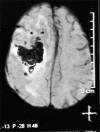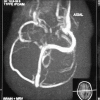Cerebral venous sinus thrombosis-A primer for emergency physician
- PMID: 32670974
- PMCID: PMC7346905
- DOI: 10.4103/jfmpc.jfmpc_192_20
Cerebral venous sinus thrombosis-A primer for emergency physician
Abstract
Cerebral venous sinus thrombosis (CVT) is notoriously known for its varied presentations and extremely high risk of mortality, if remains undetected and untreated. On the other hand, life can be saved with full functional recovery if CVT can be identified with high index of clinical suspicion with supportive imaging and treatment with appropriate anticoagulation. It is important for clinicians to be meticulous to screen for both the potential reversible and heritable causes of CVT so that appropriate measures can be taken to prevent such catastrophe. Here we report a case of CVT involving right sigmoid and transverse sinuses presenting with acute onset left sided hemiplegic without antecedent headache or seizures. Patient was successfully treated with anticoagulants with nearly full functional recovery. Multiple predisposing factors were identified. As per our knowledge, this is the first case of CVT with underlying conglomeration of multiple acquired (lactation, folate deficiency, hyperhomocysteinemia, depot medroxyprogesterone acetate injection) and hereditary risk factors (deficiency of protein C, protein S and antithrombin-III) in a single patient.
Keywords: Anticoagulation; cerebral venous sinus thrombosis; neuroimaging.
Copyright: © 2020 Journal of Family Medicine and Primary Care.
Conflict of interest statement
There are no conflicts of interest.
Figures



References
-
- Devasagayam S, Wyatt B, Leyden J, Kleinig T. Cerebral venous sinus thrombosis incidence is higher than previously thought: A retrospective population-based study. Stroke. 2016;47:2180–2. - PubMed
-
- Pai N, Ghosh K, Shetty S. Hereditary thrombophilia in cerebral venous thrombosis: A study from India. Blood Coagul Fibrinolysis. 2013;24:540–3. - PubMed
-
- Ghoneim A, Straiton J, Pollard C, Macdonald K, Jampana R. Imaging of cerebral venous thrombosis. Clin Radiol. 2020;75:254–64. - PubMed
Publication types
LinkOut - more resources
Full Text Sources
Research Materials
